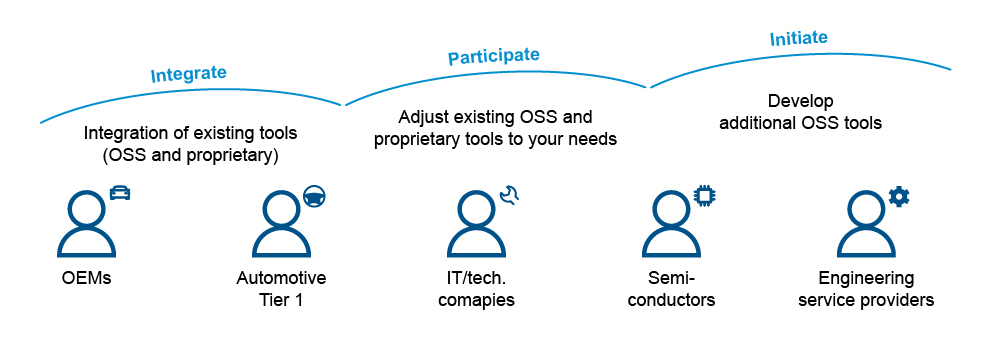Notice: this Wiki will be going read only early in 2024 and edits will no longer be possible. Please see: https://gitlab.eclipse.org/eclipsefdn/helpdesk/-/wikis/Wiki-shutdown-plan for the plan.
OpenADx
Contents
Welcome to OpenADx
Automated Driving (AD) is clustered into three equally important technology areas:
1) In-vehicle technology
2) Cloud technology (backend)
3) Test and validation tools (tool chain)
OpenADx is focused on the AD tool chain. The goal is to accelerate AD development through open collaboration and open source.
OpenADx' vision is to ensure transparency and make the complex AD tool landscape more easily accessible for enterprise users.
Challenge
AD is a complex challenge and therefore requires a multifaceted development process incorporating a variety of software tools. The tools the industry currently uses are very good, but they don’t seamlessly work with one another. This is a result of the tools not being designed to work together. This is an industry-wide issue that slows us down in the race to AD development. By pooling resources, we can remove the “friction” between widely used tools. We can create something of use to all of us: open, compatible and accessible.

Problem and benefits for OEMs
User insight: "Developing automated driving functions is extremely complicated and requires the use of many complex software tools which do not work efficiently with one another. What I need is a set of tools which work with each other seamlessly so that my teams can move through the development process more quickly and efficiently."
Benefit: The automated driving tool chain allows your team to work together more efficiently with a suite of highly integrated tools by enabling seamless transfer of data and code through each step of the automated driving development process.
Problem and benefits for tool providers
User insight: "Currently, tools used to create automated driving applications do not work efficiently with one another. If our tool is compatible with other widely used SW tools, it will ease the development process for our customers and make our products even more attractive to them."
Benefit: The seamless integration of your software tool in the automated driving tool chain makes it more attractive to organizations developing automated driving applications by increasing their development efficiency.
Integrated tool chain for AD system development
Leveraging the current tool landscape and tying in players from industry and academia is a must. Therefore, our approach is two-fold. First, we will fine-tune the development tool chain to the needs of our industry. We do this by integrating existing products in the market, adjusting existing tools to our needs, and developing additional tools through Open Source Software (OSS) where none today currently exist. Second, we will bring areas of expertise together in order to make the complex AD tool landscape more easily accessible for all stakeholders.
Approach
We believe an initiative like this should be inclusive, not exclusive. It’s about removing barriers to efficient development with widely established tools. It’s about bundling industry competencies and sharing development. We plan to demonstrate our ability to work together on joint testbeds in an open source setting. This allows potential partners to engage with a limited initial investment. The testbeds produce demonstrable results and strengthen confidence in the approach.
Join
eclipsecon Europe Automotive Unconference
Workshop results, Sept. 19, 2017 (Stuttgart)
Strategy discussion results
Partners
- Certification organizations
- Universities
- Research institutes
- Standardization organizations like AUTOSAR can provide areas to watch out for
- These are in addition to already identified OEM, tier1, hi-tech, tool providers, silicon chip
Communication
- Need slide deck with a narrative to socialize inside of respective organizations
- Set up a public community under Eclipse management for contribution and preparation work prior to next workshop 23 October
- Weekly telecom to disseminate information – attendance voluntary based on availability
- Hosted communication at e.g. 3D Experience Forums by e.g. Dassault
Execution and milestones
- Further workshop to detail testbeds/incubators - October eclipsecon Europe
- Testbed/incubator execution (Hackathon/Hackfest) – November 2017
- Group composition for hackathon to be determined based on results of testbed/incubator layout
- Testbed/incubator completed by the end of 2017
- Announcement – venue dependent on testbed/incubator results and feasible timing (forums: CES, BCW, Software in Automobiles, Toulouse, Embedded World, WCX – sponsor is SAE International)
Forms of contribution by community members
- Manpower – e.g. programming capacity
- Monetary investment
- Material support - e.g. a car for demonstration purposes
Testbed/Incubator discussion results
- Simulation (formerly #11) – Workshop 1
- ROS in the loop
2. Driver to Driver communications
- Hybrid human -vs- autonomous driving behavior differenced – very hard problem
- Reference / canonical data set - Data Sharing across companies
- Share crash incident data across companies rapidly to accelerate safety resolution
- Open Scenarios - Common ways of defining scenarios
5. API standardization – common way of calling / creating API’s
6. Management & usage of big data
- Massive data ingest
- There’s major value in driving agreement on how data is stored; can we drive agreement in which sensors are used and the format of the sensor data.
- This could benefit government agency that will test using the data to determine the safety of the vehicles
8. Heterogeneous data formats and data fusion
- Compatibility of measured data
- Visualization of data from different sources (lidar, video, measurements) could be very valuable
Testbed/incubator point of discussion
- Are the 2 testbeds in your top 10 problem list?
- What other scenarios would you add?
- What contributions might your organization make?
End-to-end processing & workflow
Assets
Pitch deck to be used inside of respective organizations



